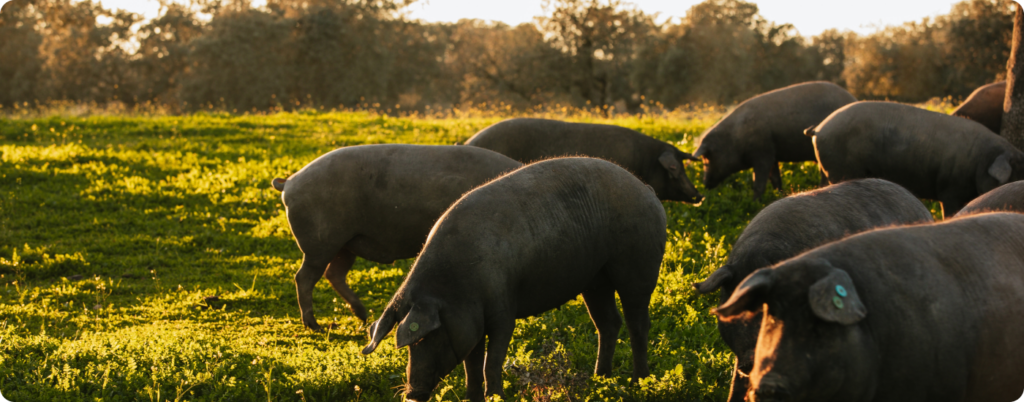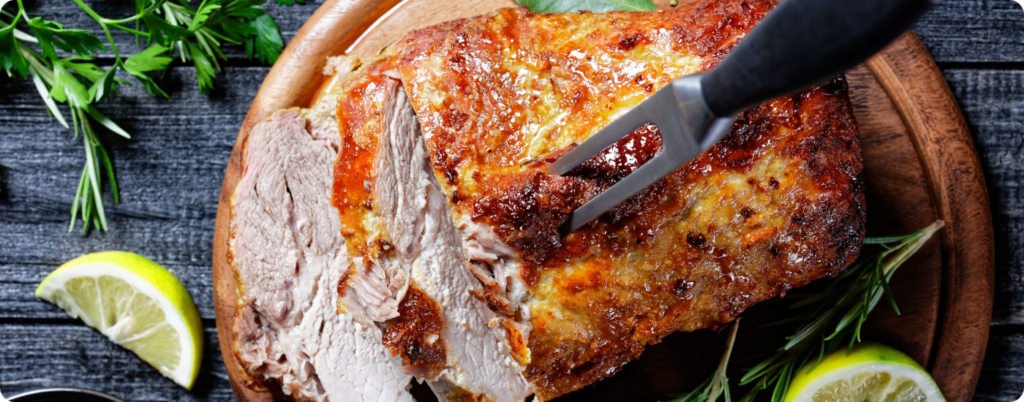While beef often takes center stage in the world of red meat, pork has stirred up its fair share of controversy, especially among health-conscious eaters. You may have heard pork is too fatty or too processed compared to other animal proteins… but is pork unhealthy, or is there more to the story?
When raised and sourced from the right place, pork can absolutely be a nourishing part of an animal-based diet. It’s rich in leucine, vitamin B1, and other nutrients that support metabolism, muscle growth, and overall health.
In this post, we’ll break down the benefits and risks of pork so you can make informed choices that support your health goals.
What You’ll Learn
- The difference between ruminant and monogastric animals
- The truth about saturated fat
- Fats to avoid for optimal health
- Common types of pork and how they compare
- 5 benefits of high-quality pork
- Pork recipes to try
Ruminant vs. Monogastric Animals
To understand pork’s place in the animal-based world, we need to zoom out. First, we must consider how pigs digest food because that affects the quality of their fat.
Ruminant Animals
Ruminants like cows, sheep, and goats have four stomach compartments; the first one is called the rumen. This complex system allows them to ferment and convert fibrous plant material into usable energy and saturated fat, making their meat rich in beneficial compounds like omega-3s, conjugated linoleic acid (CLA), vitamin E, and other fat-soluble vitamins (1).
This metabolic superpower turns grass into highly nourishing meat, which is why beef is often considered the gold standard.
Monogastric Animals
Monogastric animals, like pigs (and humans!), have a single-chamber stomach. They don’t ferment their food like ruminants do, which is a big deal when it comes to fat. Pigs cannot convert polyunsaturated fatty acids (PUFAs) into saturated fats, so their meat is higher in PUFAs, especially if they’re fed a diet of corn and soy, which most are (2).

Saturated Fat vs. Polyunsaturated Fatty Acids
For decades we’ve been warned that saturated fat is the villain behind heart disease, but that claim was built on a false narrative. Modern research has debunked the “diet-heart hypothesis,” showing that saturated fat can support longevity. It helps fuel the mitochondria and aids in hormone production (3, 4).
While saturated fats may raise LDL cholesterol, this isn’t inherently harmful because LDL is crucial for many body functions. LDL is mainly problematic when oxidized, a process fueled by factors such as a sedentary lifestyle, disruptions to circadian rhythm, and excessive consumption of unstable polyunsaturated fatty acids (5).
Our bodies only need about 1–2% of dietary fat to come from linoleic acid (a primary type of PUFA), yet the average American consumes closer to 6–10%. Excessive consumption of polyunsaturated fatty acids, particularly linoleic acid, is known to negatively affect metabolism, thyroid function, inflammation, insulin resistance, and obesity (6).
Not All Pork is Created Equal
When it comes to answering the question “is pork unhealthy?”, how the pigs are raised makes all the difference. Let’s break down the 3 major types of pork you’ll find on the market, and which one is worth a spot on your plate.
- Grain-Fed (Conventional) Pork
This is the most common type of pork found in grocery stores. The pigs are raised in confined areas and fed a grain-based diet that almost always contains corn and soy, which are high in polyunsaturated fatty acids.
Conventionally raised pigs accumulate linoleic acid in their fat, which can be pro-inflammatory when consumed in excess. Additionally, conventionally raised pork may be exposed to antibiotics and hormones.
- Pasture-Raised Pork
Pasture-raised pork comes from pigs that are allowed to forage in natural environments. These pigs consume grass, roots, acorns, and insects and are often supplemented with some grains.
While still potentially high in PUFAs depending on the grain content, pasture-raised pork generally has a better omega-3 to omega-6 ratio and is higher in nutrients like vitamin D (7).
- Soy-Free and Corn-Free (Low-PUFA) Pasture Raised Pork
This is the best choice! These pasture-rased pigs eat a natural, species-appropriate diet and are not fed feeds with PUFA-rich corn or soy that compromise fat quality.
Seek out minimally processed, uncured pork options from trusted farms that raise pasture-raised pigs without soy or corn. If you can’t find any from your local butchers, there are numerous options, such as US Wellness Meats, Apsey Farms, and Firebrand Meats.

Top 5 Nutritional Benefits of Pork
High-quality soy-free and corn-free pork is a nutritional powerhouse, offering a rich array of essential vitamins, minerals, and amino acids that support everything from muscle growth to mood.
1. Muscle Growth & Recovery
Pork is naturally rich in leucine, an amino acid that stimulates muscle protein synthesis, and vitamin B12 (cobalamin), which helps build red blood cells, supports nerve health, and fuels overall energy production (8, 9).
2. Energy Metabolism
Vitamins B1 (thiamine) and B3 (niacin) in pork help convert carbohydrates into usable energy, support brain health, and promote healthy circulation and mitochondrial function (10).
3. Skin, Collagen, & Gut Health
Amino acids like lysine and threonine promote collagen production for skin integrity, enhance immune resilience, and help maintain a strong, healthy gut lining (11).
4. Thyroid & Immune Support
Pork provides a rich source of selenium, a potent antioxidant that supports thyroid hormone conversion, protects against oxidative stress, and strengthens immune function (12).
5. Sleep & Mood Regulation
With tryptophan, a precursor to melatonin, and vitamin B6 (Pyridoxine) to support neurotransmitter function, pork helps promote restful sleep, emotional stability, and mental clarity (13, 14).

Favorite Animal-Based Pork Recipes
Here are a few of our favorite ways to enjoy high-quality pork:
Check out the Carnivore Code Cookbook for over 100 animal-based recipes using pork, beef, fruit, butter, gelatin, and more.
We also have many recipes in our free Heart & Soil Community!
Is Pork Unhealthy? The Bottom Line
An ideal animal-based diet prioritizes meat from nutrient-dense ruminant animals like beef and bison because their unique digestive systems convert unsaturated fats into more stable saturated fats, resulting in meat naturally lower in inflammatory PUFAS.
However, pork doesn’t need to be off the table! Opt for organic, pasture-raised pork that is corn-free and soy-free. High-quality pork from a trusted farm can be a nourishing complement to your animal-based routine, offering flavor and flexibility without compromising your health goals.
Subscribe to future articles like this: